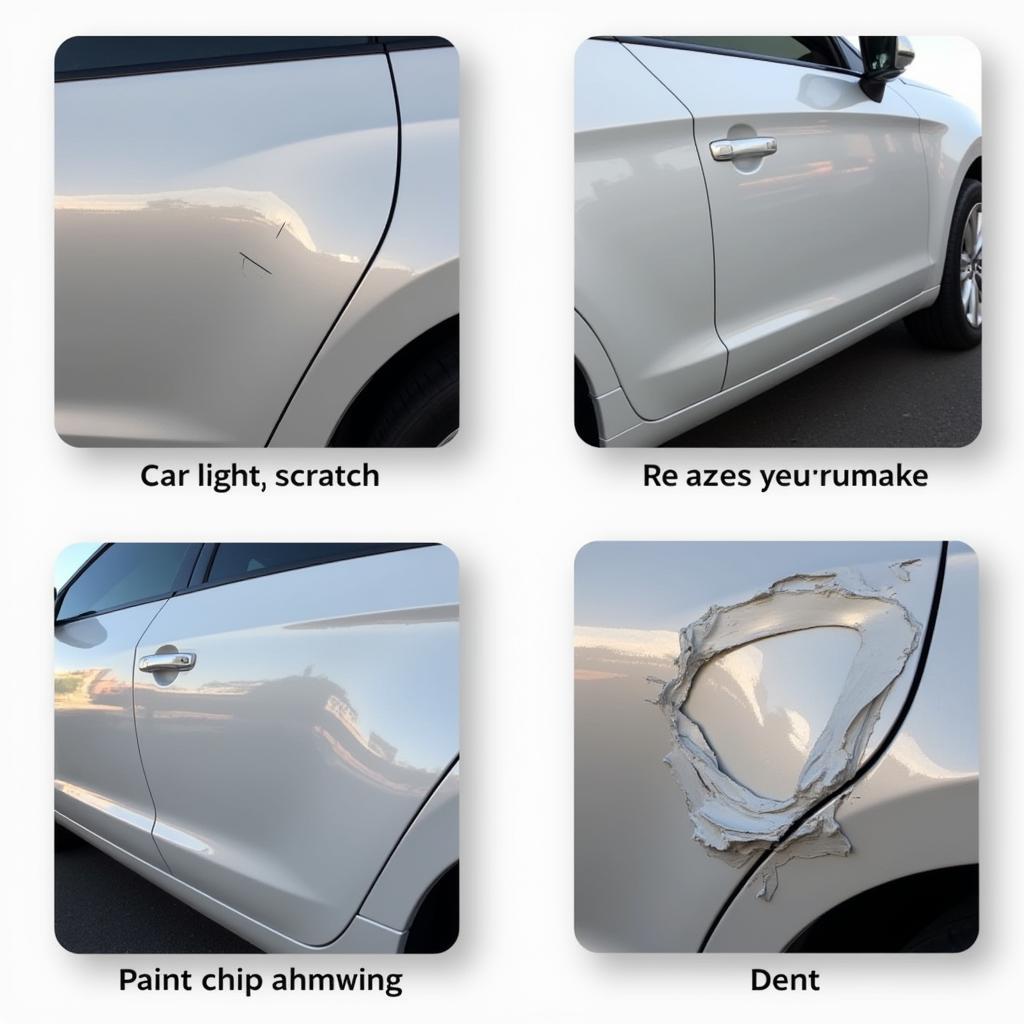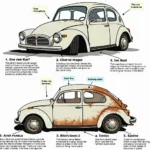Repairing car paint is essential for maintaining your vehicle’s appearance and protecting it from rust and further damage. Whether it’s a minor scratch, a paint chip, or more extensive damage, understanding your options for repair paint for cars can save you money and keep your car looking its best. This guide will cover everything from DIY fixes to professional repairs, helping you make the best choice for your situation.
Choosing the right repair paint for cars can be tricky. From touch-up paint pens to full respraying, the options can seem overwhelming. This guide breaks down the different types of car paint repair, helping you choose the best approach based on the damage and your budget. Let’s start with understanding the types of damage you might encounter.
Types of Car Paint Damage
Scratches and Swirl Marks
These are often caused by improper washing techniques or minor abrasions. They usually only affect the clear coat and can often be addressed with polishing compounds. For deeper scratches that reach the base coat, touch-up paint might be necessary. Check out our article on how to repair chips in paint on cars for more information.
Paint Chips
Chips expose the metal underneath the paint, making them susceptible to rust. Addressing these quickly is crucial. Paint chip repair kit for cars can effectively seal the chip and prevent further damage.
Dents with Paint Damage
Dents often come with paint scratches or chips. Depending on the severity, these might require professional bodywork before repainting.
DIY Car Paint Repair vs. Professional Repair
DIY Repair: Best for Minor Damage
DIY repairs are suitable for minor scratches, swirl marks, and small paint chips. Scratch pen for cars paint repair review provides insights into effective DIY solutions. You can achieve good results with the right products and a little patience.
Professional Repair: Best for Extensive Damage
For larger areas of damage, dents, or significant color mismatch issues, professional repair is recommended. They have the expertise and equipment to match the paint color perfectly and ensure a flawless finish. You can explore mobile paint repair for cars for a convenient option.
Choosing the Right Repair Paint for Cars
Matching the Paint Code
Finding your car’s paint code is the first step in choosing the right repair paint. This code is usually located on a sticker inside the driver’s side doorjamb, glove compartment, or under the hood. Using the correct paint code ensures a perfect color match.
Types of Repair Paint
- Touch-up Paint Pens: Convenient for small chips and scratches.
- Aerosol Spray Cans: Ideal for larger areas and DIY repairs.
- Paint Pen Applicators: Offers greater precision for filling in chips.
Choosing the best paint repair kit for cars will depend on the specific damage and your DIY skills.
Tips for Successful Car Paint Repair
- Clean the area thoroughly: Remove dirt and grease before applying any repair paint.
- Sand the damaged area: Create a smooth surface for better paint adhesion.
- Apply primer (if necessary): Primer helps the paint adhere and provides a uniform base.
- Apply thin coats of paint: Multiple thin coats are better than one thick coat.
- Allow sufficient drying time: Patience is key for a professional-looking finish.
“Proper surface preparation is the key to a successful car paint repair,” says John Smith, an Automotive Refinishing Specialist with over 20 years of experience. “Taking the time to clean and sand the area properly will ensure the best results.”
Conclusion
Repairing your car’s paint is a worthwhile investment, preserving its value and appearance. Whether you choose a DIY approach or seek professional help, understanding the different options for repair paint for cars empowers you to make informed decisions. By addressing paint damage promptly, you can prevent further deterioration and keep your car looking its best for years to come.
FAQs
- How do I find my car’s paint code? The paint code is usually found on a sticker inside the driver’s side doorjamb, glove compartment, or under the hood.
- Can I repair a dent myself? Minor dents can sometimes be repaired with DIY kits, but larger dents require professional attention.
- How long does touch-up paint take to dry? Drying time varies depending on the product, but it’s generally best to allow at least 24 hours.
- What is the best way to prevent car paint damage? Regular washing and waxing, parking in shaded areas, and using a car cover can help protect your car’s paint.
- How much does professional car paint repair cost? The cost varies depending on the extent of the damage and the shop’s rates.
- Can I use any type of paint for car repair? No, you should always use automotive paint specifically designed for cars.
- What if the touch-up paint doesn’t match perfectly? Slight color discrepancies can sometimes be blended with polishing compound.
Common Car Paint Repair Scenarios
- Scenario 1: Small rock chips on the hood. Solution: Touch-up paint pen or paint chip repair kit.
- Scenario 2: Deep scratch on the door. Solution: Touch-up paint and clear coat, possibly requiring sanding and priming.
- Scenario 3: Dent with paint damage on the fender. Solution: Professional bodywork and repainting.
Further Information
For more in-depth guides on specific car paint repair topics, visit our articles on paint chip repair and scratch repair.
Need assistance with your car repair? Contact us via WhatsApp: +1(641)206-8880 or Email: [email protected]. Our customer service team is available 24/7.



